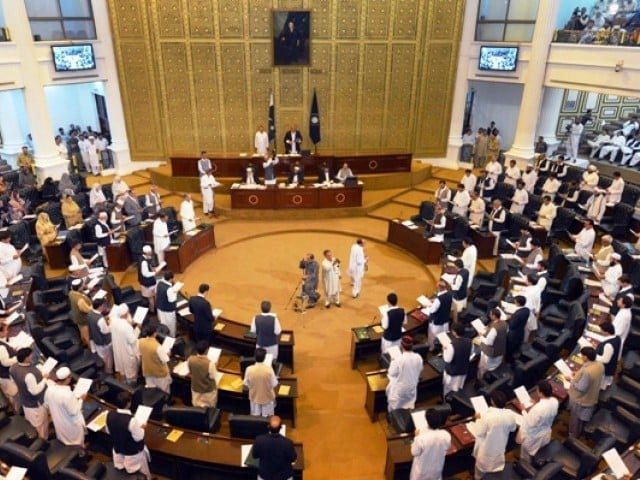K-P realistic developmental budget unveiled
Provincial govt estimates that it will get Rs491.3 billion from the federal govt

PHOTO: AFP
Khyber-Pakhtunkhwa (K-P) first-time Finance Minister Taimur Saleem Jhagra announced the budget in the provincial assembly on Monday amid loud protests from the opposition members over the Pakistan Tehreek-e-Insaf (PTI) government’s criticism of the previous Pakistan Muslim League-Nawaz (PML-N) government in the centre.
Jhagra said that they were presenting an extraordinary budget for what was arguably an extraordinary time for the national economy, adding that economic and financial decisions taken in Islamabad had a deep bearing on the economy of K-P since the province got 90 per cent of its revenue from the federation.
Despite the talk of the extreme financial situation of the country, Jhagra presented a mid-year budget whose total outlay was still 7.5 per cent higher than the Rs603 billion for the entirety of 2017-18.
As was expected, the K-P government has allocated Rs180 billion for the Annual Development Programme (ADP), which is 13.4 per cent less than last year.
However, the government allocated Rs438 billion for current, non-development expenditures. This reflects a 10.9 per cent increase over last year’s budget.
Revenue
The K-P government is expected to be largely dependent on money from the federal government in lieu of various payments and royalties.
The provincial government estimates that it will get Rs491.3 billion from the federal government or around 75.82 per cent of the total provincial budget. This includes Rs360.4 billion as part of K-P’s share in the taxes collected by the Federal Board of Revenue (FBR). A further Rs43.3 billion will be provided as a percentage of the divisible pool for war on terror — which K-P has been getting under the national finance commission (NFC) award.
The government is also expecting to get Rs65 billion as net hydel profit (NHP) from the hydro-electric generation in the province and K-P’s outstanding arrears to the federal government.
“We hope we would resolve the NHP issue through the AGN-Kazi formula after which our share in the profit would cross Rs100 billion,” Jhagra stated.
K-P also expects to raise Rs22.3 billion as oil and gas royalty.
However, the province only looks to generate just six per cent of the total budget on its own with a target of Rs41.2 billion for revenue raised through taxes and other non-tax measures.
Like in the past budget, the provincial government has set aside Rs5 billion as a cushion for domestic loans.
Similarly, the government expects to get Rs71.1 billion in foreign project assistance apart from Rs39 billion in unused money left over from the last fiscal year (FY).
Expenditure
The government intends to spend Rs618 billion during FY 2018-19, including Rs180 billion for development.
Of this, Rs29.3 billion has been reserved as development funds for the local government while Rs79.5 billion for the province’s developmental projects. The remaining Rs71.1 billion will be for foreign project assistance.
On the current expenditures side, the province’s salary bill for some 512,419 employees has inflated to a whopping Rs256 billion in FY2018-19, up from Rs218 billion in the last fiscal year.
The pension bill for 145,000 pensioners will amount to a further Rs60 billion, up from Rs54 billion last year.
Salaries and pensions alone account for 74 per cent of all current expenditures and 48.76 per cent of the total budget.
The finance department has already termed this an “alarming increase” in the budget documents. However, the department has not included any plan to counter it.
“Increase in salaries and pension at such a rate leaves little room for provincial exchequer to set aside adequate funds for operation, maintenance and development,” the document notes, but provides no plans for addressing the issue.
In his speech, the finance minister told the house that the total bill for salaries and pensions amounts to Rs316 billion, up 17 per cent from Rs271 billion last year.
“This amount was Rs87 billion in 2010-11 accounting for 40 per cent of the budget but now it accounts for nearly 50 per cent of the budget,” he said, adding that they have to find means to control expenditures.
However, the only suggestion to come from Jhagra was a cut in the Rs88 billion reserved for non-development expenditures apart from the wage and pension bill to free up a further Rs8 billion for developmental schemes.
Even though K-P has foreign debt worth Rs160.7 billion (with the dollar calculated at Rs117), the provincial government has set aside a meagre Rs7.79 billion for debt servicing during the year.
Development
Of the Rs180 billion set aside for development, the government has allocated 90 per cent of the money for the 1,155 ongoing schemes with only 10 per cent of the development budget reserved for 221 new schemes.
Keeping up with its focus on education and health, the PTI government has again allocated major chunks of the developmental budgets for these two sectors.
Both, higher and lower education sectors, will get Rs20.8 billion while health will get Rs11.8 billion.
Similarly, the environment sector will get Rs3.3 billion.
But by far the largest chunk will go to the transport department — which is also responsible for completing and operating the K-P government’s flagship Peshawar Bus Rapid Transit (BRT) project — worth Rs39 billion. This will help fund the second phase of the controversial project including the construction of the bus corridor on Khyber Road connecting Aman Chowk with the Malik Saad Shaheed Flyover.
Agriculture sector and public health sectors will get Rs3.4 billion each. The irrigation and finance departments will get Rs8 billion and Rs6.1 billion respectively.
Jhagra also presented the supplementary budget of Rs23.17 billion for the year 2017-18 in the house.
Published in The Express Tribune, October 16th, 2018.













COMMENTS
Comments are moderated and generally will be posted if they are on-topic and not abusive.
For more information, please see our Comments FAQ